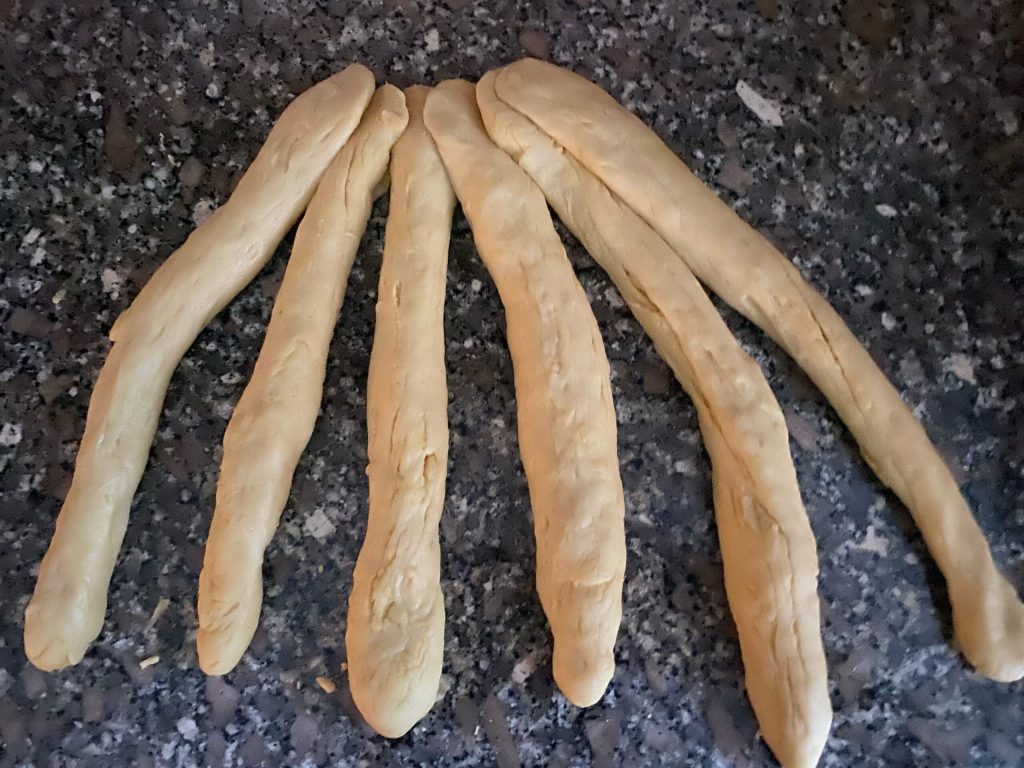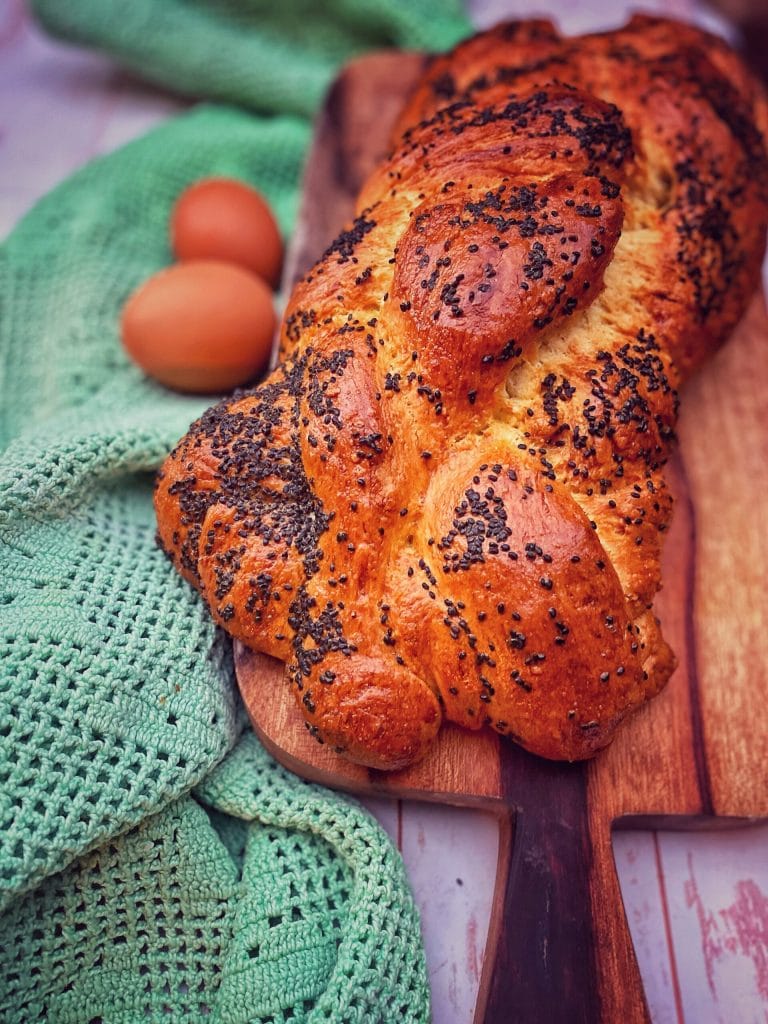The Challah Bread or Challa’ (plural Challot) is a traditional Jewish bread with a typical braided shape, slightly sweet, without butter, consumed during festive meals (excluding Pesach) and Shabbat.
In the past, it was important that the dough was made only with oat, wheat, barley, or spelt flour, today white flour is used.
The use of oil is a direct reference to that of the Temple, while the eggs give the golden color, reminiscent of the manna.
The small sesame or poppy seeds that cover the bread, recall, instead, the flakes of manna that God made fall from the sky.
At the table, two challot are always served covered by a white cloth, as a symbol of the double portion of manna covered by morning dew that God provided to the Jews stranded in the desert for forty years.
Finally, the challah bread is blessed before being consumed.
Traditionally cut with a knife among Ashkenazim and broken by hand by Sephardim – who consider knives a symbol of violence – small portions are first dipped in salt (a fundamental ingredient in past sacrifices) and then eaten.
The term challah derives from the Hebrew word chalal which means to pierce or make a hole and refers to the ritual of donating a portion of the bread to the sacred altar through the priests (the kohanim) of the temple.
Once the temples were destroyed in 70 A.D., to maintain this ritual, the rabbis imposed that after kneading the challah, a portion of about 1 oz (30 g) was blessed, wrapped in foil, and burned.
The traditional shape of the bread is a braid whose strands can vary in quantity and reach up to 12:
– 3 strands indicate peace, truth, and justice, and also the unity of the Jewish people;
– 4 strands indicate love and the crossed arms of lovers
– 12 strands (or serving two 6-strand braids) indicate the 12 tribes of Israel.

- Difficulty: Medium
- Cost: Economical
- Rest time: 4 Hours
- Preparation time: 20 Minutes
- Portions: 6 people
- Cooking methods: Oven
- Cuisine: Jewish
- Seasonality: All seasons
Ingredients
- 4 1/4 cups white flour
- 2 eggs (+ 1 for brushing)
- 1 oz sugar
- 1/2 cup water
- 1/4 cup vegetable oil (or olive oil)
- 1/4 oz dry yeast
- to taste salt
Steps
Activate the yeast in water with part of the sugar.
Mix the eggs with sugar and oil, add the flour, the yeast dissolved in water, and salt.
Knead, form a ball, and let it rise, covered, for about 2-3 hours.
Form balls, from each make strips that will then be braided by joining the ends of each (see photo).

Braid and let it rise for another hour.
Brush with beaten egg, decorate with poppy and sesame seeds.
Bake in a static oven at 350°F (180°C) for 25-30 minutes.

FAQ (Questions and Answers)
Why is butter not used for making Challah?
In accordance with Jewish dietary laws that do not allow the joint consumption of meat and dairy products.
What is Shabbat?
On Shabbat, that is, Friday evening, right after sunset, Jews recite a prayer, the kiddush, through which they give thanks to God for creating the world and resting on the seventh day; during the kiddush.
The word Shabbat, derives from the Hebrew verb “shabat” meaning “to cease” and specifically refers to the rule that prescribes ceasing certain actions and activities, foremost among them work.
Genesis tells us that God, after creating the universe in six days, rested on the seventh.
Every practitioner of the Jewish religion is required to abstain from work and a host of activities on Friday evening to fully devote themselves to God on Saturday.
Shabbat begins at sunset on Friday and ends at sunset on Saturday.What is the kiddush?
A Jewish prayer recited over a glass of wine before the Friday evening meal.
Transliterated Hebrew text
yom ha-shishì va-ichullù ha-shamaim ve-ha-arez vechol zevaam.
Va-ichal E-lohim ba-iom hasheviì melachtò asher ‘asà, va-ishbot ba-iom-ha-sheviì mikol melachtò asher asà. Va-ivarech E-lohim et-iom ha-sheviì va-ikaddesh, otò, ki vò shavat mikol melacthò asher barà E-lohim la-asot.
Savrì maranan (Le Chajim).
Baruch attà A-donai E-lohenu melech ha-olam borè peri ha-gafen.
Baruch attà A-donai E-lohenu melech ha-olam asher kiddeshanu be-mizvotav ve-razà vanu veshabbat kodshò be-aavà uv-razon hinchilanu zikkaron le-maasé ve-reshit techillà le mikraè kodesh
zecher liziat mizraim, ki vanu vacharta veotanu kiddashta mikkol ha-ammim, ve-shabbat kodshechà be-aavà uv-razon hinchaltanu,
Baruch attà A-donai mekaddesh ha-shabbath.
Baruch A-donai asher natan menuchà le-ammò Israel be-iom shabbat kodesh.
Translation
On the sixth day, the heavens and the earth and everything in them were completed. God, having finished the work he had done on the seventh day, ceased all the work he had completed on the seventh day. God blessed the seventh day and sanctified it, for on it, he ceased all the work he had completed.
With the permission of those present (May you be for life).
Blessed are You, Lord our God, who created the fruit of the vine.
Blessed are You, Lord our God, King of the Universe who sanctified us with your commandments, who loves us and who, with love and benevolence, gave us in legacy the Sabbath sacred to You, in memory of creation; first among the sacred holidays, in memory of the exodus from Egypt; yes, you chose us and consecrated us among all the peoples, and gave us in legacy with love and benevolence the Sabbath sacred to You: blessed are You, Lord, sanctifier of the Sabbath.
Blessed be the Eternal who has given rest to His people Israel on the day of the Holy Sabbath.Are Kiddush and Kaddish the same prayer or are there differences?
No, the kaddish is a prayer recited after the death of a parent, child, spouse, or sibling.
It is traditional to recite the Mourner’s Kaddish in the presence of the congregation daily for thirty days, or 11 months in the case of a deceased parent, and subsequently on each anniversary of the death.
(You can find a splendid reading in the episode 7 of “The Patient”)

